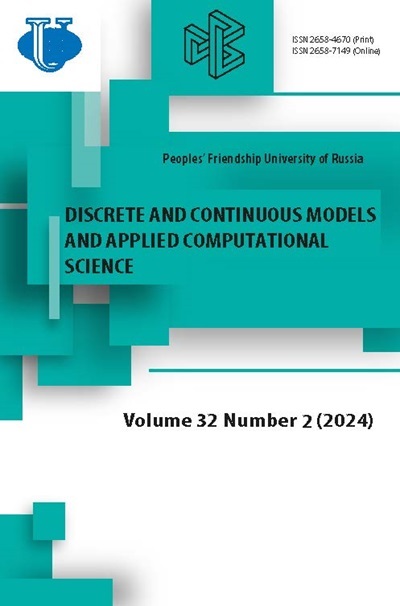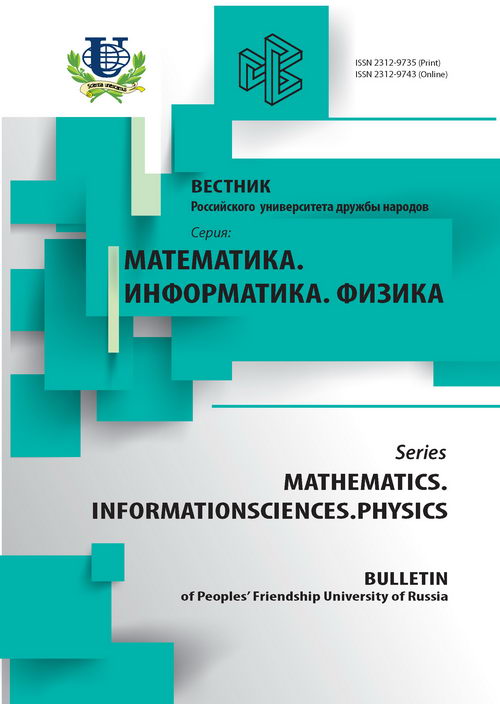№ 2 (2016)
Анализ и алгоритм расчёта вероятностных характеристик для одного абонентского узла пассивной оптической сети
Аннотация
В настоящее время телекоммуникационная индустрия претерпевает беспрецедентные изменения, связанные с переходом от голосовых систем к системам передачи данных, что является следствием бурного развития сетей связи, быстрого роста числа пользователей, увеличения числа предоставляемых услуг и их качества. Эволюция сетей доступа идёт по двум основным направлениям: развитие высокоскоростного доступа для предоставления услуг с высоким уровнем качества обслуживания и уменьшение доли медных кабелей при организации местных сетей. Доминирующее положение занимает трафик данных, который в свою очередь требует создания сетей связи с высокой пропускной способностью на базе технологии коммутации пакетов. Поэтому большое внимание уделяется сетям, при построении которых задействованы оптические и оптоэлектронные компоненты. Пассивная оптическая сеть - это полностью оптическая сеть, которая использует в своей архитектуре только пассивные оптические компоненты, исключающие преобразование сигнала из электрической формы в оптическую и наоборот. Передача трафика в такой сети может быть реализована как на базе временного, так и на базе частотного разделения каналов. В работе представлена модель фрагмента мультисервисной пассивной оптической сети, в которой осуществляется передача восходящего потока трафика с учётом особенностей функционирования оптических абонентских узлов и принципа динамического распределения длин волн. Результаты анализа процесса передачи трафика применяются в анализе вероятностных характеристик предложенной модели.
Discrete and Continuous Models and Applied Computational Science. 2016;(2):5-12
 5-12
5-12


Аппроксимация решения краевых задач локально-кубическим сплайном
Аннотация
Построен явный локально-кубический сплайн для аппроксимации гладких функций и рассмотрены его аппроксимативные свойства. Предложена сплайн-схема для численного решения краевых задач, основанная на свойствах локально-кубического сплайна и обычного коллокационного кубического сплайна. Схема реализуется путём последовательного решения двух трёхдиагональных систем, отличающихся друг от друга лишь правой частью, что позволяет использовать метод трёхточечной прогонки. Это свидетельствует о том, что данный алгоритм является эффективным, количество операций линейно зависит от числа узлов сетки. Доказано, что построенный сплайн обладает такими же аппроксимативными свойствами, что и локально-кубический сплайн. Таким образом, в данной работе фактически рассматриваются вопросы аппроксимации решений краевых задач. Предложенная схема позволяет найти решение краевой задачи и его первую и вторую производные в узлах равномерной сетки с точностью четвёртого порядка по шагу сетки. Теоретические выводы подтверждены численными экспериментами. Благодаря хорошим аппроксимативным свойствам и простоте алгоритма реализации предложенный метод может быть применён для численного решения краевых задач для обыкновенных дифференциальных уравнений второго порядка, которые часто встречаются как в математике, физике, так и в области естественных и инженерных наук.
Discrete and Continuous Models and Applied Computational Science. 2016;(2):13-23
 13-23
13-23


Символьно-численное решение уравнения Шредингера для вращающегося тела методом диагонализации
Аннотация
Методом диагонализации найден спектр и собственные функции гамильтониана вращающегося квантового волчка с тремя произвольными моментами инерции в системе базисных функций, реализующей все четыре неприводимые представления группы D2, относительно преобразований которой исходный гамильтониан не изменяется. Для собственных значений при небольших значениях вращательного момента J = 1,2,3,4 были получены аналитические формулы, а в случае произвольных значений вращательного момента представлены системы уравнений, которые с использованием современных компьютерных пакетов прикладных программ позволяют достаточно просто вычислить спектр и волновые функции асимметричного волчка. В качестве примера для вращательного момента J=50 приведены вычисленные в среде MAPLE собственные значения и их зависимость от параметра асимметрии.
Discrete and Continuous Models and Applied Computational Science. 2016;(2):24-36
 24-36
24-36


Об одном методе сглаживания двумерной поверхности
Аннотация
Регрессионный анализ ставит перед собой задачу отыскания функциональной зависимости между наблюдаемыми величинами изучаемого процесса. При этом исходные данные являются реализацией случайной величины, поэтому рассматривается зависимость математического ожидания. Такую задачу можно решать путём «сглаживания» исходных данных. Под сглаживанием понимается попытка удаления шума и несущественных фрагментов при сохранении наиболее важных свойств структуры данных, то есть результат подобен математическому ожиданию. Сглаживание данных, как правило, осуществляется путём параметрической или непараметрической регрессии. В случае параметрической регрессии необходимы априорные знания о форме уравнения регрессии. Большинство исследуемых данных, однако, невозможно параметризовать. С этой точки зрения непараметрическая и полупараметрическая регрессии представляются лучшим подходом к решению задачи сглаживания. Целью исследования ставилось разработка и реализация алгоритма быстрого сглаживания двумерных данных. Для достижения этой цели были проанализированы предыдущие работы в данной области и разработан свой подход, улучшающий предыдущие. В результате, в данной работе представлен алгоритм, который быстро и с минимальным потреблением памяти очищает данные от «шума» и «несущественных» частей. Для подтверждения «эффективности» алгоритма проведены сравнения с другими общепризнанными подходами на смоделированных и реальных данных. Результаты этих сравнений также приведены в статье.
Discrete and Continuous Models and Applied Computational Science. 2016;(2):37-43
 37-43
37-43


Модель квантовых измерений Курышкина-Вудкевича для атомов и ионов с одним валентным электроном
Аннотация
Конструктивная форма модели квантовых измерений Курышкина-Вудкевича детально разработана для квантовой задачи Кеплера. Для более сложных квантовых объектов такая конструкция неизвестна. В то же время стандартная (не конструктивная) модель квантовых измерений Холево-Хелстрома годится для любого квантового объекта. Целью данной работы является распространение конструктивной модели квантовых измерений на более широкий класс квантовых объектов - модель квантовых измерений оптического спектра атомов и ионов с одним валентным электроном. В работе модель Курышкина-Вудкевича, реализующая правило квантования Вейля-Курышкина в приложении к квантовой задаче Кеплера, распространена на квантовые системы с одним валентным электроном, например, на атомы щелочных металлов. В основу доказательства состоятельности модели положены две теоремы Като о компактных возмущениях операторов. В ходе доказательства получены явные формулы дискретного спектра валентного электрона для различных спектральных серий, зависящие от сериальных параметров возмущения спектра изолированного объекта в процессе квантовых измерений.
Discrete and Continuous Models and Applied Computational Science. 2016;(2):44-52
 44-52
44-52


Устойчивость нелинейных колебаний пологих оболочек двоякой кривизны
Аннотация
В статье рассматриваются высокоамплитудные (геометрически нелинейные) колебания пологих оболочек двоякой кривизны c прямоугольными границами, свободно опертых по всем четырем краям и подвергающихся нормальному к поверхности гармоническому воздействию в спектральной окрестности основной формы. Первая часть проведенных исследований была представлена в работе [М. Амабили и др. Нелинейные колебания пологих оболочек двоякой кривизны // Вестник КГТУ, 2015. - Т. 18, № 6. - С. 158-163] авторов. Для расчета энергии упругой деформации были использованы два различных нелинейных соотношения между деформацией и перемещением: из теории Доннелла и теории Новожилова. Учитывались также геометрические несовершенства формы оболочкии и влияние инерции в плоскости. Построены приближенные уравнения динамики в форме уравнений Лагранжа второго рода. Предполагается, что потенциальная энергия сил упругости разлагается в ряд, в котором ограничиваются членами третьего порядка. Для исследования устойчивости невозмущенного движения используется метод функций Ляпунова и метод характеристичных чисел. Полагая функцию Ляпунова квадратичной формой с постоянными коэффициентами, определяются условия, при которых решение, соответствующее невозмущенному движению системы при гармоническом воздействии, является устойчивым. Определяется оценка наибольшего характеристичного числа Ляпунова. Приводятся результаты численных экспериментов, полученных для системы с гармоническим возбуждением. Рассматривается случай сферической оболочки, исследуется эффект влияния различной кривизны, проводится бифуркационный анализ.
Discrete and Continuous Models and Applied Computational Science. 2016;(2):53-63
 53-63
53-63


Симметричное шифрование на основе метода расщепления
Аннотация
Предлагаемое в статье расщепление касается защищенных способов передачи информации о каждом отдельном символе при их потоковой передаче. Расщепление является обобщением процедуры защищенной передачи с одиночным ключом. Интеллектуальность расщепления состоит в обратимом кодировании (reversible coding) отдельных символов вместо использования теоремы отсчетов Котельникова-Шеннона для передачи по каналу связи последовательности блоков символов, с целью повышения степени защиты. Описан действующий вариант системы, предназначенный для передачи текстовых сообщений. В этой статье показано, как использовать набор криптографических ключей, которые генерируются с применением генетического алгоритма, и как выбрать генератор псевдослучайных чисел, чтобы решить некоторые современные криптографические задачи.
Discrete and Continuous Models and Applied Computational Science. 2016;(2):64-72
 64-72
64-72


Свойства плёнок диоксида титана с металлическими наночастицами
Аннотация
В работе исследовались физико-химические свойства плёнок диоксида титана, содержащих наночастицы золота, изготовленных по гель-технологии. Проведено сравнение разных технологий синтеза диоксида титана. Экспериментально показано, что разработанная гель-технология позволяет получать практически 100% фазу наноструктурированного анатаза, что было подтверждено методами микроскопии высокого разрешения и результатами рентгеноструктурного анализа. Проведены исследования топографии и морфологии полученных образцов плёнок. Изучена фотоактивность синтезированных плёнок методом ЭПР-спектроскопии. Показано увеличение фотоактивности плёнок при УФ-облучении. Проведена модификация диоксида титана наночастицами золота разной концентрации. Исследованы спектры пропускания в зависимости от соотношения компонент раствора при изготовлении гель-плёнок, а также от температуры отжига при их формировании. Показано, что спектры поглощения существенно зависят от параметров технологического режима. Исследование спектров поглощения плёнок диоксида титана с содержанием наночастиц золота показало существенные изменения спектров, а именно: возникали дополнительные пики поглощения разной интенсивности и наблюдался сдвиг края полосы пропускания. Эти изменения обусловлены, по-видимому, изменением структуры плёнок, а также агрегацией наночастиц золота. Проведённые исследования показали перспективность гель-метода для синтеза диоксида титана и его модифицирования наночастицами.
Discrete and Continuous Models and Applied Computational Science. 2016;(2):73-86
 73-86
73-86


Замечания к стандартной теории осцилляции K0, ¯K0 мезонов. Нарушение странности - S и CP чётности в слабых взаимодействиях в системе K0, ¯K0 мезонов
Аннотация
K0, ¯K0 мезонные осцилляции реализуются через KS, KL мезонные состояния. Нужно заметить, что KS, KL мезонные состояния возникают при нарушении CP чётности в слабых взаимодействиях, и кроме этого, эти состояния не являются ортогональными и поэтомуони не могут генерировать K0, ¯K0 мезонные осцилляции. На самом деле, при нарушении странности - S, K0, ¯K0 мезоны превращаются в суперпозиционные состояния ортогональных K10, K20 мезонных состояний, и далее через эти состояния возникают K0, ¯K0осцилляции. В дальнейшем при CP нарушении K10, K20 мезоны превращаются в суперпозиционные состояния KS, KL мезонов, и далее возникает интерференция между этими KS,KL мезонными состояниями, но осцилляции при этом не возникают. Такая картина находится в хорошем согласии с экспериментом. Итак, приходим к заключению: осцилляции K0,¯K0 мезонов реализуется через K10, K20 мезоны, а не через KS, KL мезоны.
Discrete and Continuous Models and Applied Computational Science. 2016;(2):87-94
 87-94
87-94


Сведения об авторах
Discrete and Continuous Models and Applied Computational Science. 2016;(2):95
 95
95


Правила оформления статей
Discrete and Continuous Models and Applied Computational Science. 2016;(2):96-97
 96-97
96-97
















